skip to main |
skip to sidebar
I made a version of this soup last month when I was with my family in Seattle, to go with the herby cheese pull-apart bread that was our first baking challenge set by Aparna Balasubramaniam. The soup is not exactly as I made it the first time, because mixed vegetable soup can be whatever you make of it.
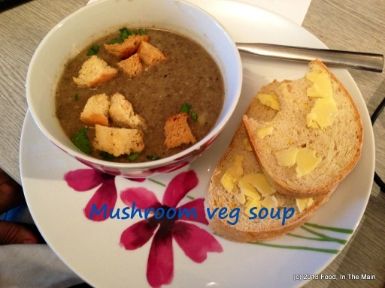
If you're a wannabe Masterchef contestant or judge, or have more money than sense, you can use expensively exotic ingredients - mushrooms that have been grown in soil imported from a remote corner of the Brazilian rain forest and watered with dew gathered in moonlight on a full moon night in June; the rarest blue-spotted heirloom potatoes from Venezuela that have been hand picked by an endangered tribe (gotta support them, don't y'know); cream from milk where the cattle were exclusively hand fed on the finest grass prepared by Cordon Bleu chefs while classical music was played by the London Philharmonic live in their air-conditioned, state-of-the-art barn (the cows' barn, I mean, not the London Philharmonic's. The London Philharmonic wouldn't be allowed to live in the same building as these super-exclusive posh cows!)... you get the idea.
OR, you could just use whatever vegetables you have in your refrigerator that need using up, and standard chestnut or white mushrooms (or whatever you can get), to make this soup. It's a guide more than a recipe, anyway.
That said, though, I bought the mushrooms specifically to make this soup. But because I have more sense than I have money, I bought them from the "reduced for quick sale" section. Yay me!
Recipe for:
Vegetable-mushroom soup

Ingredients:
4 small onions, sliced thinly
2 baby leeks (green and white parts), sliced thinly
4 cups mixed mushrooms (I used portobello/cremini, shiitake and oyster), sliced
1 medium potato, chopped (skin on)
1 medium carrot, chopped
1 litre (4-5 cups) vegetable stock/broth
1 tsp dried thyme or Italian herb mix
1 bay leaf
4 sprigs fresh thyme
1 tbsp olive oil + 1 tbsp butter
2 tbsp sour cream/Greek yogurt or full fat milk (optional)
Salt and pepper to taste
2 tbsp parsley for garnish
Method:
1. Heat the oil and butter in a large pan, add the onions and leeks and cook over medium heat till they begin to soften (about 5 minutes), stirring frequently.
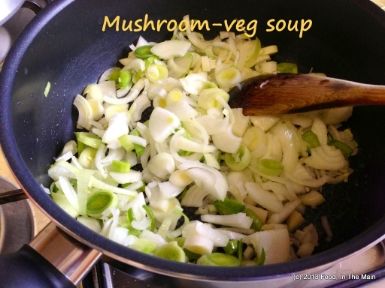
2. Add the mushrooms and cook for 2-3 minutes or till they start to reduce.
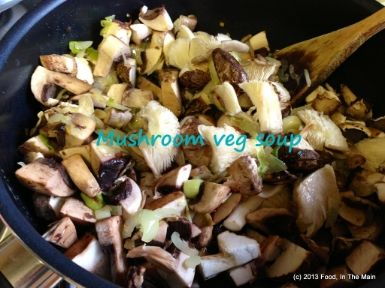
3. Add the potatoes and carrots along with the dried herbs and bay leaf. Stir for a couple of minutes.
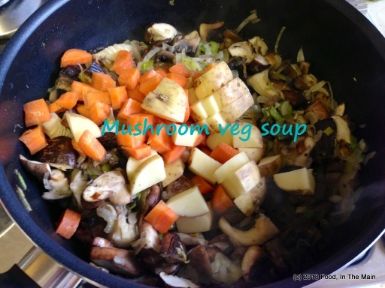
4. Then add the stock and the fresh thyme sprigs.

Bring this to a boil, cover the pan and let the stock simmer for 10-15 minutes or till the carrots and potatoes are soft and cooked.
5. Fish out the fresh thyme sprigs and bay leaf, then turn off the heat. Let the soup cool, then blend it to a smooth consistency.
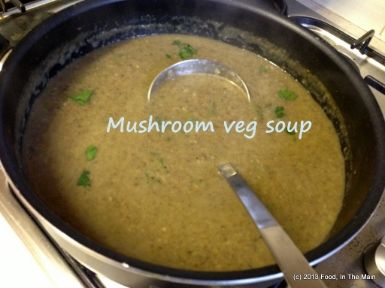
If you would like a bit more texture to the soup, blend only about 3/4 of the soup smooth, then add it to the remaining unblended soup in the pan. Add the milk or sour cream/yogurt, if using, and stir it in. Add salt and pepper to taste. Reheat on low heat till thoroughly warmed, but do not let it boil. Serve with parsley sprinkled on top, and croutons if you like, and crunchy buttered toast on the side.
What does the term "salad" mean to you? Something with green leaves, tomatoes and cucumber and radishes, perhaps with a dressing? That's what denotes a salad to me - even now, when I know that practically anything can be a "salad".
I have to say it used to puzzle me. What is pasta salad, anyway? Or - a very strange thing to a South Indian - rice salad? Could South Indian lemon rice or tamarind rice be classified as rice salad?
I'm still not entirely sure why something that is not a salad when hot becomes a salad when cold. Examples? Well, pasta. Eat it cold, and it's a pasta salad. Eat it hot, and it's... well, pasta. Rice, too, undergoes that transition - especially if there's wild rice in there. Take couscous, too. Pizza Hut has cold couscous in its salad bar. When is couscous a side dish, and when is it a salad? More to the point, why is it a salad when it's cold? And then those hot salads - how do THOSE come about without becoming not-salad?
I don't mean any disrespect to the West when I say that perhaps everything is a "salad" here because they don't know how else to classify the various cooked foods from other cultures? What do you think?
This recipe could be a salad, or not. It could be a side dish. Or merely a form of couscous upma. Here's a thought - perhaps we Southies call everything "upma" because salads aren't really in our culinary heritage?
Because I don't know what to call my recipe - salad, side dish, upma, whatever - I'm terming it "couscous with lentils". At least it has the virtue of literalness.
Recipe for: Couscous with lentils
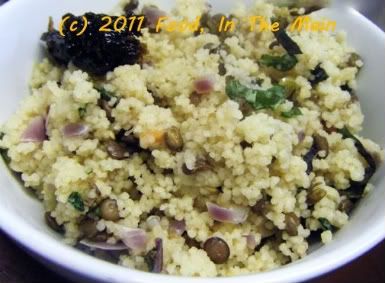 Ingredients:
1/4 cup green lentils
1 bay leaf
1 cup couscous
1 red onion, chopped finely
2 green chillies, chopped
Ingredients:
1/4 cup green lentils
1 bay leaf
1 cup couscous
1 red onion, chopped finely
2 green chillies, chopped
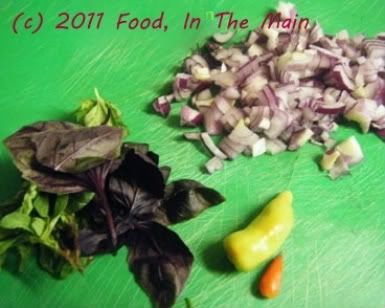 1 small tomato, chopped
2 cloves garlic, minced
a handful of fresh basil leaves
Salt and pepper to taste
about 1-1/2 cups vegetable stock (or water)
1 tsp oil
Method:
1. Cook the lentils in salted water along with the bay leaf, till they're cooked but not mushy.
1 small tomato, chopped
2 cloves garlic, minced
a handful of fresh basil leaves
Salt and pepper to taste
about 1-1/2 cups vegetable stock (or water)
1 tsp oil
Method:
1. Cook the lentils in salted water along with the bay leaf, till they're cooked but not mushy.
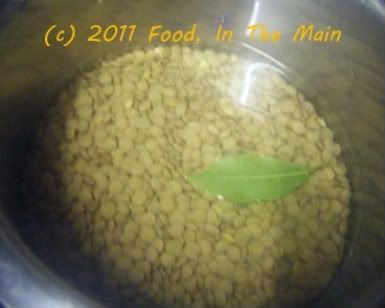 Drain and reserve.
Drain and reserve.
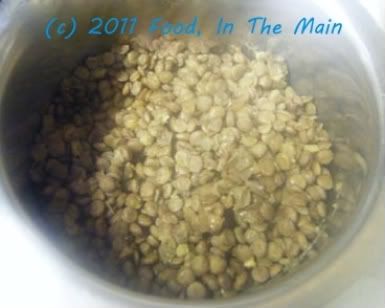 2. In a medium size pan, heat the oil and add the chopped chillies, garlic and red onion. Stir well.
2. In a medium size pan, heat the oil and add the chopped chillies, garlic and red onion. Stir well.
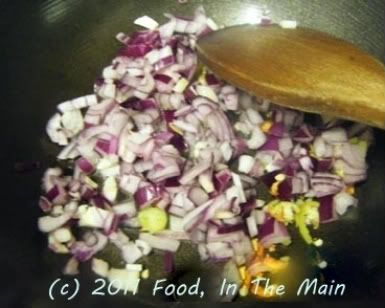 3. Let the onions soften a little, then add the chopped tomato.
3. Let the onions soften a little, then add the chopped tomato.
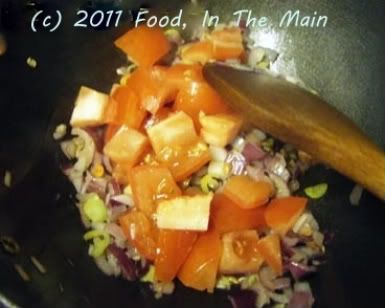 4. Once the tomatoes are beginning to break down, pour in the stock and bring to a brisk boil.
4. Once the tomatoes are beginning to break down, pour in the stock and bring to a brisk boil.
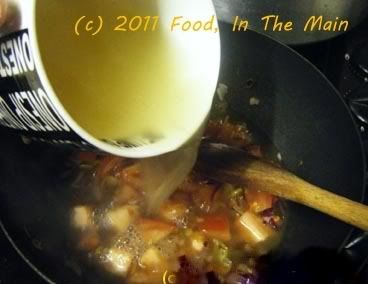 5. Now add the couscous and stir it well. Add salt to taste and bring back to the boil.
5. Now add the couscous and stir it well. Add salt to taste and bring back to the boil.
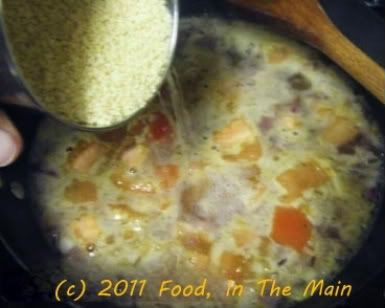 6. Turn off the heat and cover the pan with a well-fitting lid. Let the couscous rest for 10-15 minutes.
7. Once all the water has been absorbed, fluff up the couscous with a fork. Add the reserved lentils and freshly ground pepper to taste, and toss to mix, or fork it through to mix.
6. Turn off the heat and cover the pan with a well-fitting lid. Let the couscous rest for 10-15 minutes.
7. Once all the water has been absorbed, fluff up the couscous with a fork. Add the reserved lentils and freshly ground pepper to taste, and toss to mix, or fork it through to mix.
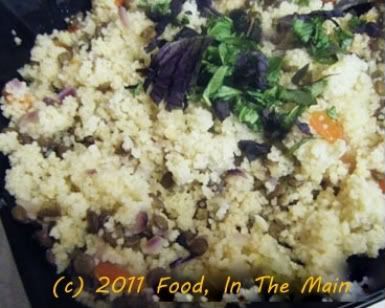 8. Garnish generously with shredded basil leaves and serve the couscous warm as a side with lamb dishes, or as a snack.
RECIPE: COUSCOUS WITH LENTILS
Ingredients:
1/4 cup green lentils
1 bay leaf
1 cup couscous
1 red onion, chopped finely
2 green chillies, chopped
1 small tomato, chopped
2 cloves garlic, minced
a handful of fresh basil leaves
Salt and pepper to taste
about 1-1/2 cups vegetable stock (or water)
1 tsp oil
Method:
1. Cook the lentils in salted water along with the bay leaf, till they're cooked but not mushy. Drain and reserve.
2. In a medium size pan, heat the oil and add the chopped chillies, garlic and red onion. Stir well.
3. Let the onions soften a little, then add the chopped tomato.
4. Once the tomatoes are beginning to break down, pour in the stock and bring to a brisk boil.
5. Now add the couscous and stir it well. Add salt to taste and bring back to the boil.
6. Turn off the heat and cover the pan with a well-fitting lid. Let the couscous rest for 10-15 minutes.
7. Once all the water has been absorbed, fluff up the couscous with a large fork. Add the reserved lentils and freshly ground pepper to taste, and toss to mix, or fork it through to mix.
8. Garnish generously with shredded basil leaves and serve the couscous warm as a side dish with meat dishes, or as a snack.
8. Garnish generously with shredded basil leaves and serve the couscous warm as a side with lamb dishes, or as a snack.
RECIPE: COUSCOUS WITH LENTILS
Ingredients:
1/4 cup green lentils
1 bay leaf
1 cup couscous
1 red onion, chopped finely
2 green chillies, chopped
1 small tomato, chopped
2 cloves garlic, minced
a handful of fresh basil leaves
Salt and pepper to taste
about 1-1/2 cups vegetable stock (or water)
1 tsp oil
Method:
1. Cook the lentils in salted water along with the bay leaf, till they're cooked but not mushy. Drain and reserve.
2. In a medium size pan, heat the oil and add the chopped chillies, garlic and red onion. Stir well.
3. Let the onions soften a little, then add the chopped tomato.
4. Once the tomatoes are beginning to break down, pour in the stock and bring to a brisk boil.
5. Now add the couscous and stir it well. Add salt to taste and bring back to the boil.
6. Turn off the heat and cover the pan with a well-fitting lid. Let the couscous rest for 10-15 minutes.
7. Once all the water has been absorbed, fluff up the couscous with a large fork. Add the reserved lentils and freshly ground pepper to taste, and toss to mix, or fork it through to mix.
8. Garnish generously with shredded basil leaves and serve the couscous warm as a side dish with meat dishes, or as a snack.
And this time it's REAL gravy, the Western kind, not the inadequate translation of some South Indian kuzhambu into English!
Yesterday's supper for Pete was sausages and mash (mashed potatoes), and he was hankering after onion gravy to go with it. So I looked through some gravy recipes online and discovered that it's not exactly a complicated thing to make. The main ingredients are onions and stock.
I don't usually go to the trouble of making stock from scratch, so I used a fancy pork-flavour Knorr stock cube (the one currently being peddled by chef Marco Pierre White on TV) to make the stock. I'm sure a vegetarian stock cube will do just as well, for those of you who are purists. They probably taste the same, anyhow.
Anyway, the secret to a lipsmacking onion gravy lies in the way the onions are cooked - basically with some butter, long and slow, till they are brown and caramelised BUT NOT BURNT. The balsamic vinegar is the final touch.
The onion gravy was oh-my-GOD yummy and savoury - the balsamic giving that extra oomph, if you ask me. I barely managed to get some photos before Pete whisked away his plate.
Onion gravy is not particularly photogenic, especially in my hands - I'm a crap photographer. So that's why the mash and gravy look the way they do in the photos... but if flavour could be uploaded into the pix, believe me, you'd totally be licking your computer screens!
Recipe for: Onion gravy
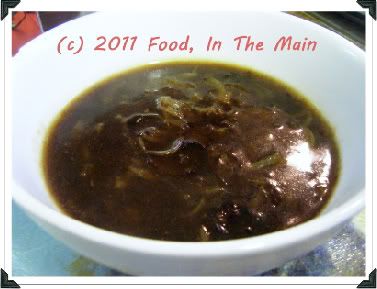 Ingredients:
2 medium onions, halved and sliced thinly
2-1/2 cups stock, instant or home-made
1/2 tbsp good quality balsamic vinegar
3/4 tsp butter
1 tsp sugar
1 tbsp cornflour
1 tsp oil (any mild/flavourless oil)
Pepper and salt to taste
Method:
1. Heat the butter and oili n a saucepan, add the sliced onion and stir well. Fry the onions on medium-high heat for 3-4 minutes, stirring, until they just start to turn colour.
2. Then turn the heat right down, cover the pan and let the onions cook for 10 minutes or till they are brown and soft.
3. Now stir in the sugar and balsamic vinegar and cook the onions for 2-3 minutes on medium-low heat.
4. Then pour in the stock and bring to a boil. After 2-3 minutes, dissolve the cornflour in some water (or in some stock taken from the pan) and add it to the gravy.
Ingredients:
2 medium onions, halved and sliced thinly
2-1/2 cups stock, instant or home-made
1/2 tbsp good quality balsamic vinegar
3/4 tsp butter
1 tsp sugar
1 tbsp cornflour
1 tsp oil (any mild/flavourless oil)
Pepper and salt to taste
Method:
1. Heat the butter and oili n a saucepan, add the sliced onion and stir well. Fry the onions on medium-high heat for 3-4 minutes, stirring, until they just start to turn colour.
2. Then turn the heat right down, cover the pan and let the onions cook for 10 minutes or till they are brown and soft.
3. Now stir in the sugar and balsamic vinegar and cook the onions for 2-3 minutes on medium-low heat.
4. Then pour in the stock and bring to a boil. After 2-3 minutes, dissolve the cornflour in some water (or in some stock taken from the pan) and add it to the gravy.
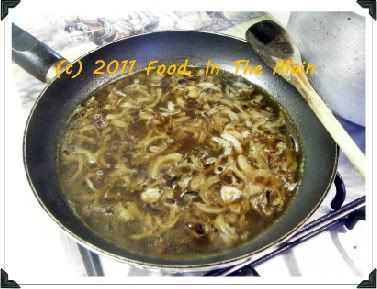 5. Stir well, then add salt and pepper to taste. Let the gravy simmer till it thickens. Ideally, it should not be runny.
5. Stir well, then add salt and pepper to taste. Let the gravy simmer till it thickens. Ideally, it should not be runny.
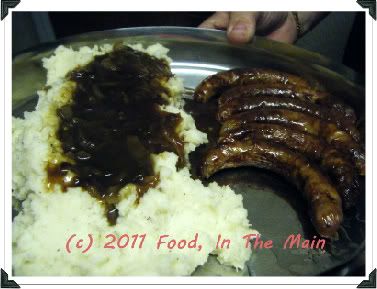 Serve hot with vegetarian (or real) sausages and mashed potatoes for a very English supper.
RECIPE: ONION GRAVY
Ingredients:
2 medium onions, halved and sliced thinly
2-1/2 cups stock, instant or home-made
1/2 tbsp good quality balsamic vinegar
3/4 tsp butter
1 tsp sugar
1 tbsp cornflour
1 tsp oil (any mild/flavourless oil)
Pepper and salt to taste
Method:
1. Heat the butter and oili n a saucepan, add the sliced onion and stir well. Fry the onions on medium-high heat for 3-4 minutes, stirring, until they just start to turn colour.
2. Then turn the heat right down, cover the pan and let the onions cook for 10 minutes or till they are brown and soft.
3. Now stir in the sugar and balsamic vinegar and cook the onions for 2-3 minutes on medium-low heat.
4. Then pour in the stock and bring to a boil. After 2-3 minutes, dissolve the cornflour in some water (or in some stock taken from the pan) and add it to the gravy.
5. Stir well, then add salt and pepper to taste. Let the gravy simmer till it thickens. Ideally, it should not be runny.
Serve hot with vegetarian (or real) sausages and mashed potatoes for a very English supper.
Serve hot with vegetarian (or real) sausages and mashed potatoes for a very English supper.
RECIPE: ONION GRAVY
Ingredients:
2 medium onions, halved and sliced thinly
2-1/2 cups stock, instant or home-made
1/2 tbsp good quality balsamic vinegar
3/4 tsp butter
1 tsp sugar
1 tbsp cornflour
1 tsp oil (any mild/flavourless oil)
Pepper and salt to taste
Method:
1. Heat the butter and oili n a saucepan, add the sliced onion and stir well. Fry the onions on medium-high heat for 3-4 minutes, stirring, until they just start to turn colour.
2. Then turn the heat right down, cover the pan and let the onions cook for 10 minutes or till they are brown and soft.
3. Now stir in the sugar and balsamic vinegar and cook the onions for 2-3 minutes on medium-low heat.
4. Then pour in the stock and bring to a boil. After 2-3 minutes, dissolve the cornflour in some water (or in some stock taken from the pan) and add it to the gravy.
5. Stir well, then add salt and pepper to taste. Let the gravy simmer till it thickens. Ideally, it should not be runny.
Serve hot with vegetarian (or real) sausages and mashed potatoes for a very English supper.




















